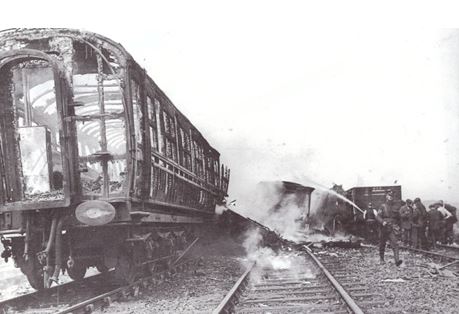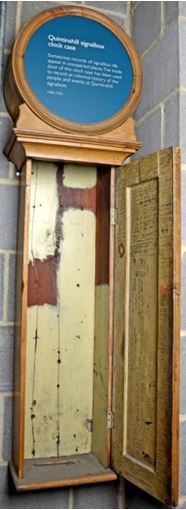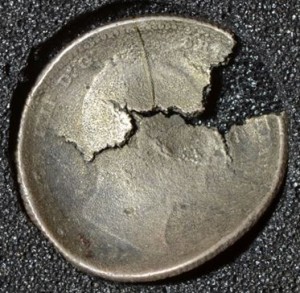The devastating accident on the Caledonian Railway at Quintinshill near Gretna on 22 May 1915 is Britain’s greatest railway disaster.
At least 227 people were killed in a multiple crash exacerbated by a fire which engulfed the wreckage. The majority of deaths came from the 1/7th (Leith) Battalion the Royal Scots who were journeying to Liverpool to board a troop ship on its way to Gallipoli. Instead, the Battalion was decimated and barely a family in the historic port of Leith – from where the men had been recruited – was left untouched by the tragedy.

The National Railway Museum contains two objects connected to this disaster; both very different in character but each standing as witness to those terrible events.

Our first object is the clock case from Quintinshill signal box. Timekeeping was essential to the running of not just an efficient but a safe railway. Safety policies were there to be enforced but on that day there were a number of breaches of official policy that took place at Quintinshill. Now devoid of the clock mechanism the case stands as a silent witness to the disaster that unfolded.
The crash was blamed on the poor working practices of Quintinshill’s signalmen, George Meakin and James Tinsley. Time played its part. Tinsley should have relieved Meakin at 6am but an arrangement between the two men allowed Tinsley to arrive half an hour late for duty after hitching a ride on a local train. The crew of the train waited in the box to allow late running cross border trains to pass whilst Tinsley backfilled the log to take into account the 30 minutes that he should have been on shift. Meakin was reading the paper Tinsley had brought with him. Neither signalman seemed aware of the time – perhaps lost in the distractions of so many people being in the signal box as the clock ticked ominously towards the time of the first collision: 6.49am. Just over a minute later a third train would crash into the wreckage.
The crash investigation found Meakin and Tinsley guilty of culpable homicide. The signal box in which the men had worked would be forever tainted by the tragedy. Although the box was demolished in the 1970s the clock case – minus the mechanism and face – has survived to represent the role of the fatal errors made inside the signal box on that fateful day. There is a curious legacy to this clock. Inside the case Meakin and Tinsley’s successors marked the date of the crash and signed their names. Subsequent signalmen further added their names as well as other pieces of information such as General Election results, deaths of railway workers in service and dates of union strikes. This act of memorialising inside a signal box that was witness to such an horrific accident seems both touching and appropriate.
If the clock bears witness to the accident itself then our second item, a coin from the reign of William IV, is testimony to the ferocity of the aftermath of the crashes when fire raged through the broken and scattered carriages.
The transportation of troops during the First World War involved huge trains traversing the whole length and breadth of the country. With the increase in traffic older carriages were put into use as was the case of the troop train involved in the Quintinshill accident. These older carriages – from the Great Central Railway – were lit by gas. Extra gas was stored under the carriage bodies in cylinders which had recently been recharged before the train had left Larbert. These cylinders ignited after the final train had crashed into the earlier wreckage. The fire was so fierce that the bodies of many of the soldiers could not be identified and their remains were buried in a mass grave at Rosebank Cemetery, Edinburgh.

Amongst artefacts recovered from the scene was this little coin its metal twisted and scalded, evidence of the unimaginable fire that engulfed the wreckage. This coin has added poignancy for it is a shilling – one of almost 4 million minted in the reign of William IV. But this is also – we may reasonably assume – a King’s shilling, the, by then, symbolic indication that a man had joined the armed forces.
Often soldiers would keep their shillings as a keepsake – perhaps even a symbol of luck. Many would become family heirlooms. But the coin now in the National Railway Museum was uncovered by a railway worker clearing through the wreckage of the Quintinshill crash – its owner unknown but its broken and contorted form surviving as testimony to the massive loss of life amongst a group of young soldiers setting out to War.
» More information about the Quintinshill disaster is in this article from the latest ‘NRM Review’ by the Friends of the NRM.
» On Saturday 23 May at 11:30am, 1:45pm and 3pm our volunteers will be re-enacting the disaster at our Signalling School in the Warehouse.
» Find out more about Health and Safety on the railway in our online exhibition.
I have just found about the signatures on the inside of the door of the clock from the Quintinshill signal box. My grandfather John Cowper was a relief signalman with the Caledonian Railway based in Carlisle. He relieve the two signalmen on the day of the accident and can be seen in several of the accident photographs taken during the site clearance operation (he is wearing the signalman’s uniform). He recovered a very battered swagger stick form the site which eventually came into my possession. I recently donated this to the Devils Porridge Museum at Gretna. His uncle John Cowper was the driver of the pilot engine of the north bound express. John Cowper’s son John Cowper (my grandfather’s 1st cousin) was killed in the accident at Dinwoodie in 1928. His son Gerald Cowper was born in 1929 and has recently passed away in June 2018.
I am intrigued by the signatures on the door and I would like to know how I can find out if my grandfather’s signature is among those on the door. No one in the family knew that he had the swagger stick in his possession until he died in 1957 and he never spoke to me about that day.
Regards,
John Cowper
John – I think you and I are related. Gerald Cowper was my father. It seems that we share a great great grandfather!
Regards
paul cowper
Seriously, this is the National Railway Museum? Hopeless!
1) The train crew did not, as you claimed, wait in the box while Tinsley filled in the Train Register. Only the fireman, George Hutchinson, came to the box three minutes after his arrival to carry out Rule 55, and he left before the accident. The advent of Hutchinson to the box is critical; Tinsley had stood behind him on his way to work just minutes earlier and he was in the box barely seconds before the signalman had forgotten the local completely and had accepted the troop special.
2) The arrangement was aimed at benefiting both men, as they admitted at the inquiry.
3) Tinsley getting the local train to work once a week was not the motivation for the arrangement, which had started almost immediately upon Meakin’s assignment to the box around the start of 1912. Only with the outbreak of war in August 1914 did the local start being shunted at Quintinshill on a regular basis.
4) You failed to mention that although Meakin claimed to have been ‘just reading the paper’, he did admit that he may have drawn the attention of the other men in the box to interesting articles.
5) You also did not mention that while the gas did not help, the inquiry found that the coal dust would have been ignited anyway by the fires from the crashed locomotives. The dreadful Great Central stock provided was most certainly a factor, but the government had the power to insist on better yet chose not to use it.
6) Finally, there is the most shocking thing of all which seems to always get overlooked by those commenting on this tragedy. This illegal arrangement between Tinsley and Meakin, albeit likely unofficially sanctioned by their superiors who both suffered demotions in all but name afterwards, had been going on for two and half years when the Great War started. Both men knew full well that the massively increased workload on the line thereafter meant that accidents arising from the arrangement were much more likely, yet put their dislike of early mornings before the lives of the passengers and fellow railway workers who passed through their section. All signalmen knew full well that the changeover time was when accidents were most likely to happen, yet they left it at a busier time of day which ensured that rather than listening to his mate’s telling him what was what, Tinsley was busy copying out the fifteen entries into the Train Register. Frankly they were lucky to get away with such light sentences.
Please can you tell me why my reply to John Cowper was deleted? He has mentioned three family members in his comment – my father, grandfather and great grandfather – and he appears to be related to my family. Could you pass on my email address to him and ask him to contact me please?
The William IV shilling looks to have received impact damage rather than the result of intense heat. The cracks are sharp and jagged, and meet at the join with the missing piece. The metal surface does not exhibit any of the signs of fusion or oxidation that one might expect to see from fire damage, only ordinary wear consistent with being in circulation for around 80 years. This coin was most likely damaged in one of the collisions and fell to the ground below the fire.
There is no evidence this was a “king’s shilling”. All silver coinage issued after 1816 was legal tender in the UK until 1971, and pieces often remained in general circulation for many years. In 1915 it would not have been unusual for a coin dating from 1830-1837 to have been found in change albeit in extremely worn condition as in this example. It seems likely this shilling was an item of small change in the possession of one of the victims when the accident occurred.